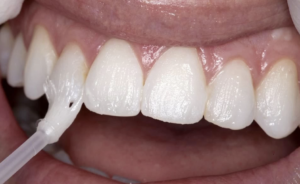 Cavities are a potential problem that everyone faces. They are even more likely to occur when there is a lack of good personal dental care. One way to help prevent cavities from forming is to go to the dentist and get special fluoride treatments.
Cavities are a potential problem that everyone faces. They are even more likely to occur when there is a lack of good personal dental care. One way to help prevent cavities from forming is to go to the dentist and get special fluoride treatments.
The Cause of Cavities
Every person has a large number of bacteria growing in their mouth. In fact, there may be as many as 700 different kinds. Some kinds of bacteria produce an acid every time they eat sugar or carbs. The bacteria accumulate on the teeth every day in an almost invisible film called plaque.
If the plaque is left on the teeth for long periods it also means that the acid is on your teeth causing erosion of the enamel. When you do not floss, and even if you do brush your teeth, the bacteria feed on the food particles between your teeth – slowly eroding away the protective enamel.
Consuming a lot of sugary drinks and foods makes the erosion take place even faster. This gives more food to the bacteria and they multiply faster and will produce even more acid. What is just as bad is that many drinks, such as soda, coffee, and fruit juices, also have their own acid – which speeds up the decay of your teeth.
The Benefit of Fluoride
The acid from the bacteria and foods that you eat are constantly leaching the minerals out of the enamel. This weakens your teeth and makes them more susceptible to breaking, cracking, and chipping. Fluoride is a mineral that helps to restore (remineralize) the minerals in the teeth, as well as helping to protect the teeth from acid.
Fluoride treatments will not restore damaged teeth because enamel does not regrow. It will only help to add minerals that have been lost. The process of demineralization and remineralization is constantly taking place, and with a healthy diet, the rate of remineralization will equal the rate of demineralization.
Types of Treatments
Treatments of fluoride at the dentist office are usually only given to people who are at a higher risk of developing cavities. The dentist will use a stronger concentration than what can be obtained at the store or in toothpaste.
Fluoride can be applied in several ways. The dentist may apply it in the form of a gel, a solution, a varnish, or a foam. It can be applied with a brush, a cotton swab, or in a tray that is held in your mouth for a few minutes.
Frequency of Treatments
A dentist may want to apply a new treatment of fluoride every three, six, or 12 months. It will depend on how much of a risk you are to develop new cavities. Risks for developing cavities include a poor diet, heavy drug or alcohol abuse, dry mouth, an eating disorder, and poor dental hygiene.
In order to get more information or to set up an appointment, just call our office at (914) 732-3377.

